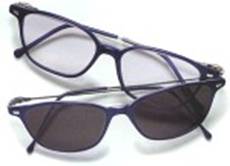|
Switchable Glazings
Leading the list of
emerging technologies for glass treatments are three types of glazings:
electrochromic glazing, photochromic glazing, and thermochromic glazing. In each
case, the glass is darkened based on different stimuli. For our purposes, none would
be appropriate for a windshield treatment since their darkening effects would exceed
the maximum amounts allowed as set forth by ANSI/SAE standards.
Electrochromic
Electrochromic (EC)
glazes can be applied to windows resulting in a darkening tint when an electric
field is run through the glazing. These glazes need
less than 5 volts of electricity to activate and can remain darkened for
an extended time without a constant electric field. The window can be returned to
its original state with a field reversal. This technology is also called
switchable glass or smart windows, and is already being used in some automobile
rear-view mirrors to regulate glare response. Sunroofs on high
end cars like Maybach and Ferrari are currently using switchable glass.
Photochromatic
Although transition lenses were first developed by Corning in the late 1960's, they did not gain international
fame until the 1990's. Known as photochromatic or photochromic lenses, this innovation in
optical technology has been used to combat a foe common to much of society, ultraviolet
rays (UV). Transition lenses get their name through their unique ability to darken
when in contact with these UV rays. The darkening effect of these “slick shades”
is created by embedding millions of microcrystalline silver halides or silver chloride
in the structure of glass lenses. Plastic lenses rely on the uses of organic photochromic
molecules (for example: oxazine and naphthopyran).
When exposed to direct sunlight the molecules in these lenses undergo a chemical
reaction that causes them to change shape. While in this new shape they begin to
absorb portions of the sunlight and darken the lenses. The rate and concentration
at which these molecules darken is entirely dependent on the intensity of the sun
light. In some cases, transition lenses have even darkened in extremely cold environments.
Once the UV rays are negated the molecules of the lenses will transform back to
there original state thus making the lenses transparent again.
An immense flaw with photochromic glazes is that they are useless behind windshields
since windshields
already negate much of the UV rays needed to alter the chemicals. Lenses with this treatment
will not darken in visible light due to difference in frequencies and energies
between visible light and UV rays. Consequently, they are unable to prevent glare
caused by oncoming head lights.
Thermochromic
This glazing method uses a
gel-based coating and results in the window automatically changing from
clear to opaque when exposed to light or warmer temperatures. This glazing
is designed to
block solar gain. Since the window loses its transparency, this glazing is
best suited for
skylights or other nonessential window treatments.
|
 Product
Product
 Liquid Crystals
Liquid Crystals Moth-eye Gratings
Moth-eye Gratings Photonic Crystals
Photonic Crystals Laws
Laws
 Manufacturing
Manufacturing
